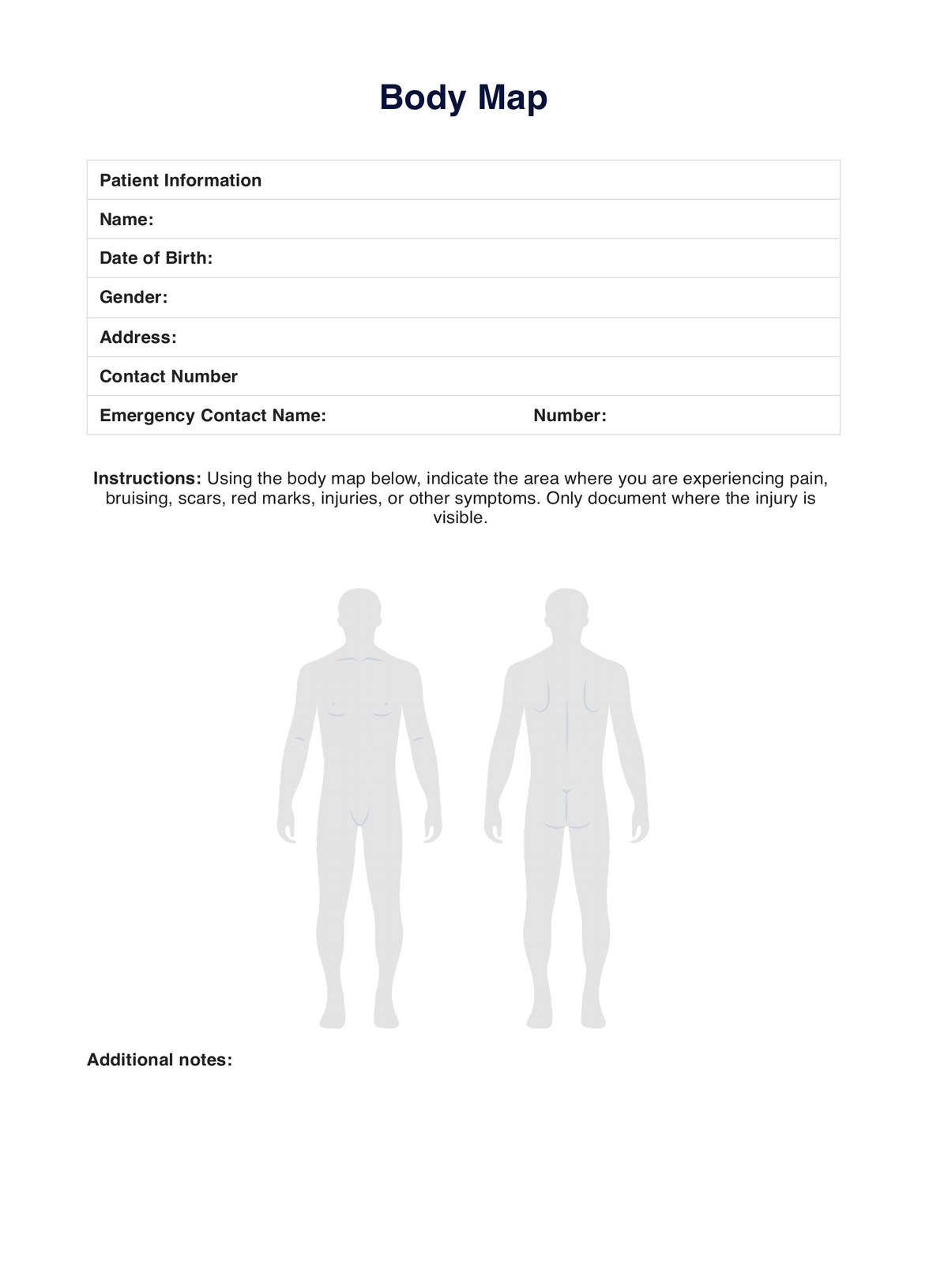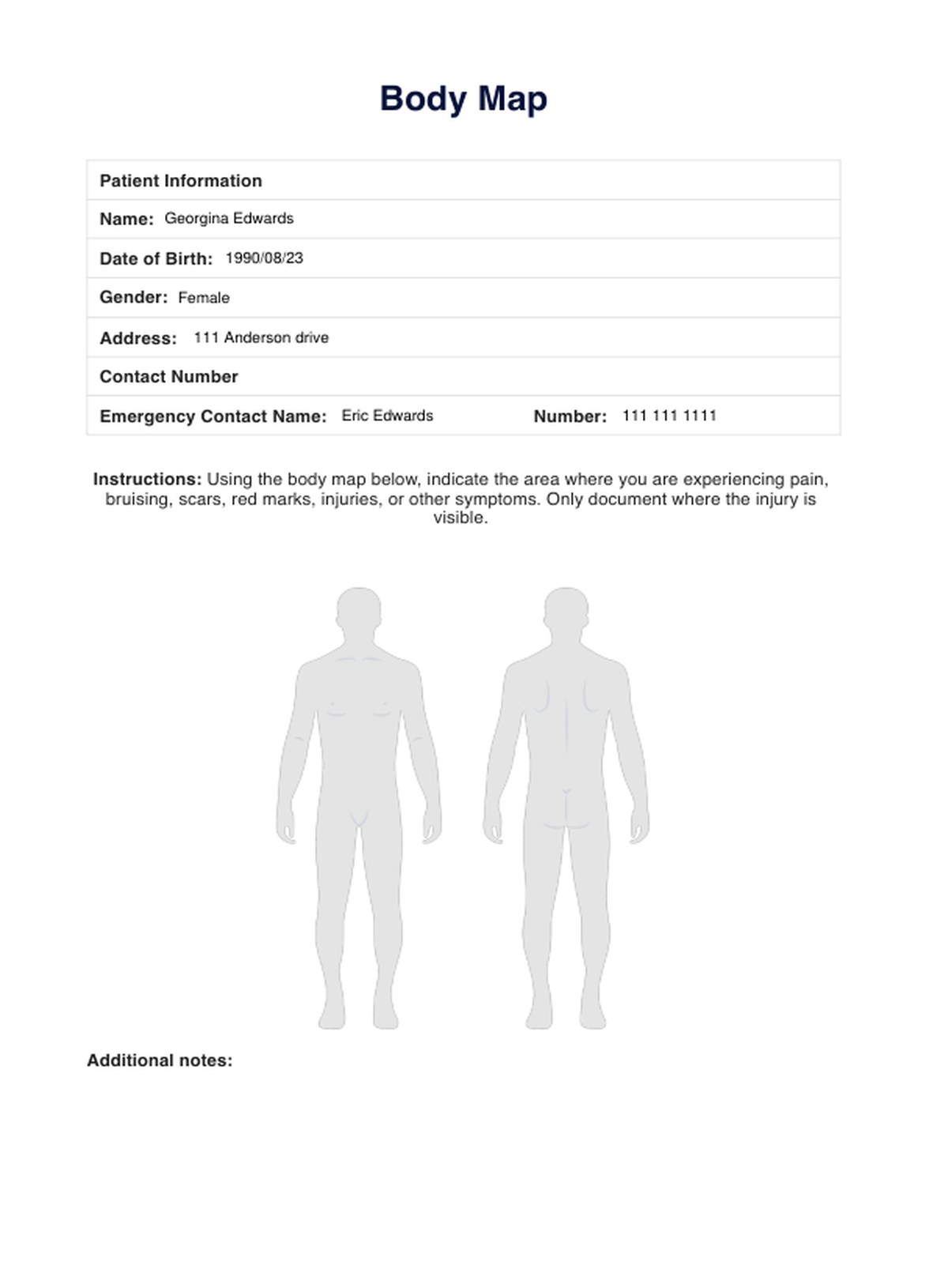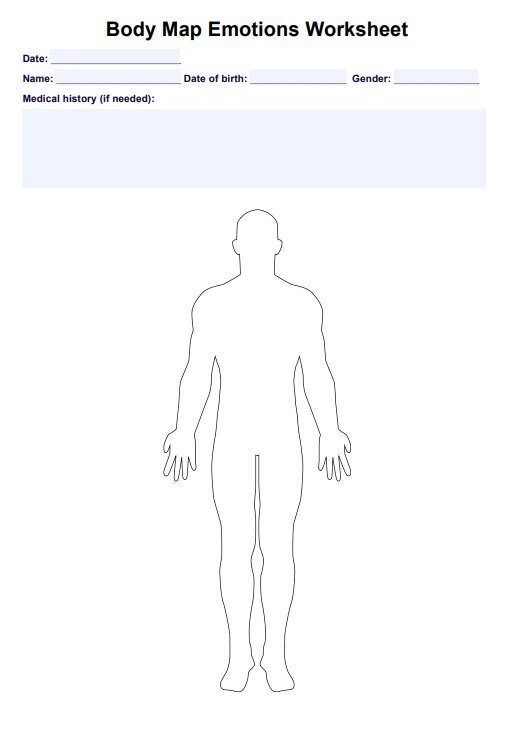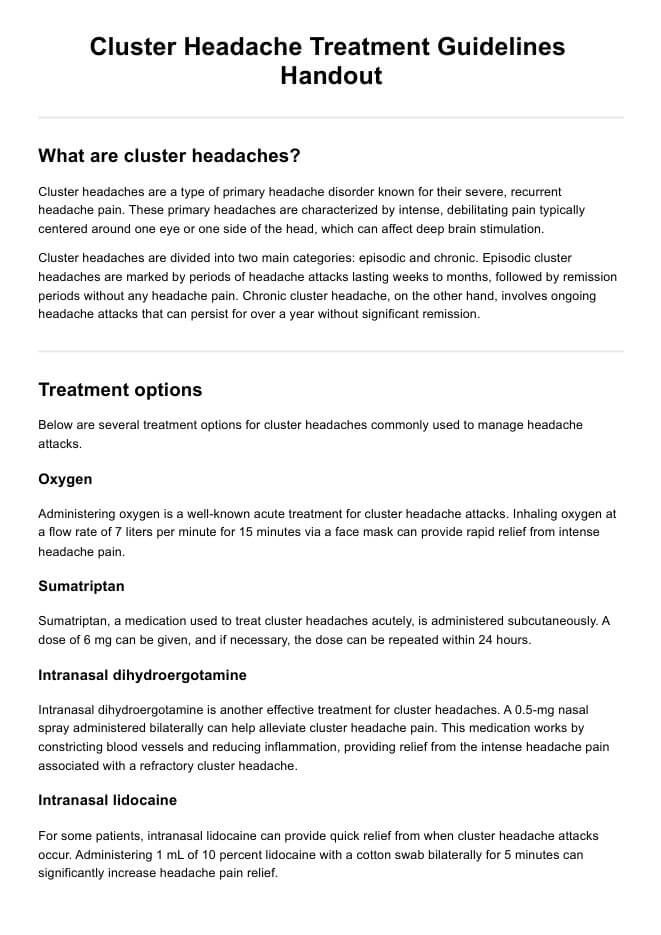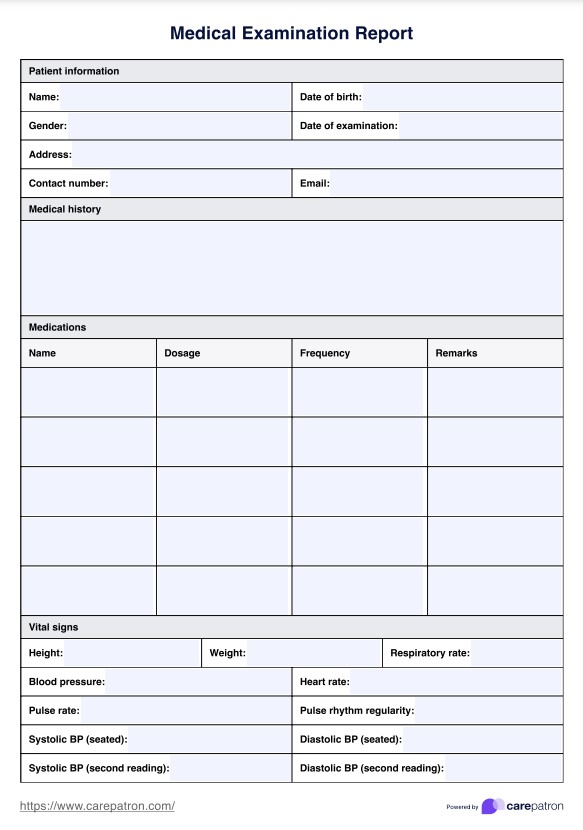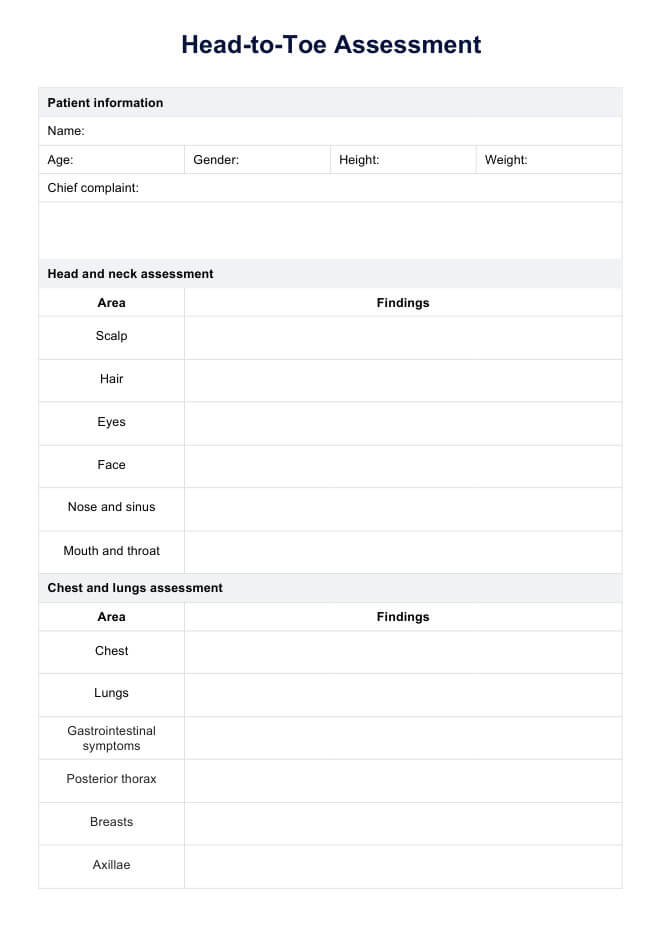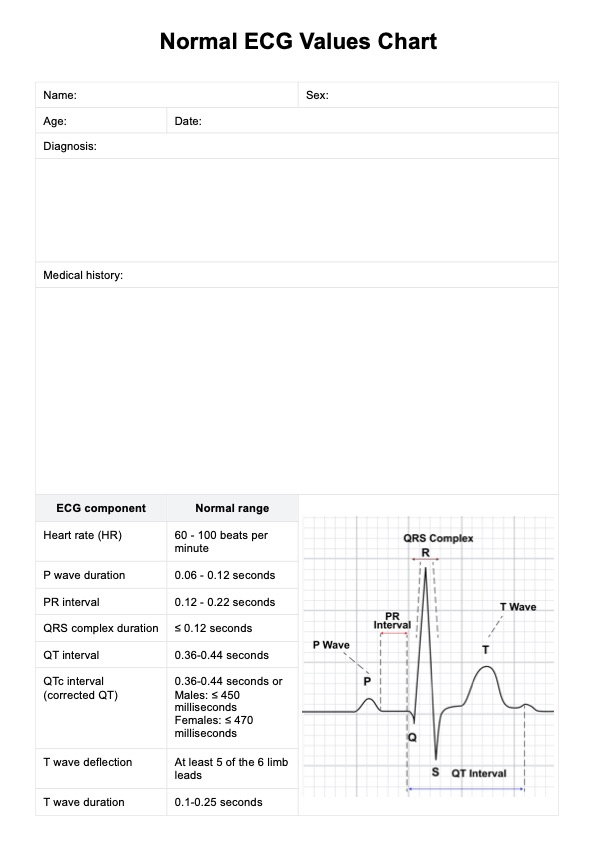Body Map Template
Having trouble locating symptoms? Use our Body Map Template to clarify ambiguities and communications to identify symptom sites.


What is a Body Map Template?
A body map template is a visual resource that displays the front and back views of a human body. The template includes the outline of a typical human body that is otherwise black to allow health practitioners and their clients to label or mark different anatomical features they wish to distinguish or identify. These templates are used broadly in various fields, including medicine, health coaching, and personal training, to provide a clear overview of human anatomy.
In a clinical sense, this template can be used by health practitioners, such as doctors and nurses, to visually communicate where and how a medical procedure may be conducted.
Using this template may be most beneficial amongst pediatric patients, patients with verbal difficulties, or patients who cannot name certain anatomical features. Because the body map is a visual resource, these patients can mark or color the areas in which they are experiencing pain or symptoms, providing insight into the area of illness or injury to the health practitioner.
As a visual resource, the body map allows health practitioners and their clients to communicate. While clients can express their injury sites, practitioners frequently use them to explain treatment and rehabilitation plans to their patients. By establishing a clear communication channel, the resource creates a transparent therapeutic relationship that fosters mutual empowerment and aspirations to enhance health.
Body Map Template
Body Map Template Example
How does it work?
Managing health and wellbeing can become simpler using our body map template, a visual resource that enhances communication between healthcare providers and their patients. To show you how our template works, we have broken down the process into the following steps:
Step 1: Obtain the template
Access our template here for an electronic version, or download a printable PDF version for a physical copy to be completed by hand.
Download the Printable Body Map Template here.
Step 2: Document patient information
Depending on the patient’s age, ask patients to complete the patient information section at the top of the template. This includes their name, date of birth, contact number, address, gender, and emergency contact information. If the patient is underage, this field should be completed by a caregiver.
Step 3: Use the body map template
As a practitioner, present the body map template to the patient. Depending on your practice’s requirements and patient’s preferences, this may be an electronic version or a physical copy. Ask patients to use symbols or colors to mark the areas in which they are experiencing pain or symptoms. Where appropriate, ask patients to provide additional information that may provide context.
Step 4: Documentation
Using the completed body map, document the nature of the symptoms from the body chart using your practice management software. This includes information regarding the location, intensity, duration, and presence of symptoms, which is essential to determining diagnosis.
Step 5: Ongoing monitoring
If the issue presented by the patient is persistent or ongoing, it is essential to continue monitoring and documenting any changes. This may involve making changes or updating the body map as required, which is critical for accurate documentation and informing future decisions.
When would you use this template?
The body map template is a resource designed to help bridge the communication between practitioners and their clients, making it broadly applicable to a range of practices. The following are some scenarios in which this template may be used:
Locating site of injury
For general practitioners or nurses, the template may be used as a way for patients to demonstrate the site of injury. In some instances, an injury may not be visible on the surface, such as an eye scratch or ligament damage. Individuals may draw attention to problem areas by using the body map, encouraging practitioners to run screening procedures that help diagnose issues.
Demonstrating procedures
Inaccurately representing areas and segments of the body, a body map can be used by practitioners to demonstrate how and where a procedure may be taking place. This may be beneficial for practitioners like physiotherapists and surgeons to demonstrate where a treatment or condition is taking place, using the map as a diagram.
Assessing pediatric pain locations
For pediatricians, this resource would be an effective way to identify an initial location for diagnosis. Often, children can be shy or may be unable to communicate the anatomically correct term for an area in which they are experiencing symptoms. Using this template may make them more comfortable, and the map can be used to help elicit information. However, it is recommended that these maps be completed by unassisted children eight years of age or over, and younger children should complete the map with support from a caregiver.
Benefits of the Body Map Template
Using a body map template can hold many positive outcomes for health practitioners and patients experiencing symptoms in locations that are difficult to locate or explain. The following are a few of the benefits that may be experienced using our free body map template:
Enhanced understanding
Individuals that use the body map template may better understand the anatomical structures comprising the body. This may be beneficial during future health consultations, as patients may be able to communicate their injury or symptoms with more detail, particularly in regards to location.
Enhanced documentation
The body map template can be used as documentation, allowing for accurate patient records. This would be most advantageous for persistent, developing illnesses or injuries, as the body map can be repeated or updated, showing the progression of the issue, which is critical for diagnosis and subsequent treatment interventions.
Improved communication
This resource can improve communication channels between health practitioners and patients. For patients who may find it challenging to communicate the issue area, such as pediatric patients, the template can clarify and be used as a communication resource. This ensures patients and practitioners are on the same page, which is critical for diagnosis and treatment.
Transparent therapeutic relationship
When there are miscommunications or misunderstandings, the therapeutic relationship can often be weakened, as patients may feel as though practitioners are not hearing or listening to them. Using this resource may develop transparency between patients and practitioners, which can enhance trust and a healthy therapeutic relationship that is necessary for effective patient care.
Research & evidence
Body maps are a resource that has been used broadly over many decades to understand the body, locate symptoms, and recognize the importance of understanding people’s perceptions to inform health care and education (Brummett et al., 2017; Cornwall, 1992).
While the origin of body maps is not defined, the use of body maps in medical contexts can stem from how people perceive the body and its processes. In particular, medical anthropologists draw light onto the concept that interpretations of the body are highly varied amongst different cultures and communities. Understanding people’s perceptions is essential to recognize needs and expectations in healthcare and education (Cornwall, 1992).
Assuming that information about the body and anatomical areas is a shared knowledge can lead to assumptions and biases, particularly by Western practitioners working with indigenous communities or minority individuals. This can be detrimental for the therapeutic relationship, patient confidence, trust and lead to poor health outcomes associated with misappraisal.
To bridge the knowledge and communication gaps, practitioners may find the body map an effective tool. In providing access to people’s perceptions of the body and an avenue for communication, the body map can be used as an explanatory model that clarifies miscommunications or ambiguities in consultation (Cornwall, 1992). Additionally, the map itself uses a universal outline of the body, which has been shown to be an easy way for patients to use and communicate (Brummett et al., 2017).
References
Brummett, C. M., Bakshi, R. R., Goesling, J., Leung, D., Moser, S. E., Williams, D. A., Clauw, D. J., & Hassett, A. L. (2017). Preliminary Validation of the Michigan Body Map (MBM). NIH, National Library of Medicine, National Center for Biotechnology Information, 156(6), 12-5-1212. https://www.ncbi.nlm.nih.gov/pmc/articles/PMC4868633/
Cornwall, A. (1992). Body mapping in health RRA/PRA. RRA Notes 16(1). https://www.iied.org/sites/default/files/pdfs/migrate/G01449.pdf
van Baeyer, C. L., Lin, V., Seidman, L. C., Tsao, J. C. I., & Zeltzer, L. K. (2010). Pain charts (body maps or manikins) in assessment of the location of pediatric pain. Pain Management 1(1). https://www.futuremedicine.com/doi/abs/10.2217/pmt.10.2
Commonly asked questions
A body map template can simply be created by accessing our electronic body map template or downloading the PDF copy to print a physical copy. Once accessed, patients can mark the areas in which they are experiencing symptoms on the body map.
Body map templates are a comprehensive resource that can be easily used in various settings, making it broadly applicable. Typical scenarios in which these templates may be useful include pediatric consultations or general practitioner appointments.
These templates are used as a visual resource that allows patients to mark areas in which they are feeling symptoms. The body map can then be discussed or shown to the practitioner, who may then investigate the marked area for symptoms or diagnosis.
Practitioners and patients can use a body map template to clarify ambiguities or miscommunications during consultations.


